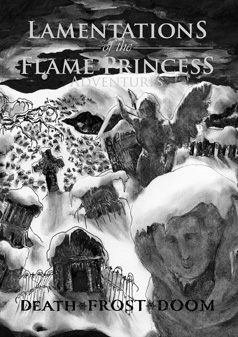So I finally got to run
this for our group. Basically Death Frost Doom re-skinned for a trio of Basque Pirates starting an extended shore leave. The system is Labyrinth Lord, borrowing simplified saving throws and ascending AC from DCC RPG, and equipment/occupations/Death & Dismemberment from
Swashbucklers & Seamonsters. There are many DFD spoilers ahead, in case you plan on playing it any time soon.
 Los Desgraciados
Los Desgraciados
The party consisted of three natives of Esquiule:
- Agurtzane- the lovely Ship's Doctor, wielding dual blunderbuss pistols--a regular Pirate foil to Dr. McNinja
- Franzisko- Pearl Diver with a crowbar for opening giant oysters and a diver's helm with a hand pump to supply air from above
- Eder- the ship's quartermaster, sporting a cutlass, dual pistols, and a keg of good rum
The Diver's Helm proved the most useful item, being used for well-diving, poison spore disposal, and even saving him from a ghul that leapt on him when he peeked out of a hole in the ground.
Pepe
Our unfortunate heroes left town quietly in the early morning, when most of the inhabitants were still hung-over on garlic-flavoured ale. They headed up the taboo mountain and towards the end of the first day met Pepe, a strange old mountain man who they suspect is a serial killer. While Eder munched on the mystery meat he gave them(the others refused to ingest it), he told them about the cursed tower and that they should stay away from it. He told them that he spends much of his time carving grave-markers for the poor souls who died there without a proper burial--the party wasn't sure to believe him, thinking perhaps the grave markers are for his victims.
As it grew late in the day, they politely rejected his offers to board them for the night. Instead, they started back down the mountain, doubled back and continued a little ways up, camping in a secluded spot.
The Tower
After a short hike the next morning they crosses a ridge and saw ahead of them the remains of the tower and a graveyard. They messily bled a tree, burned a frozen corpse, went down a well of freezing water, and then made their way to the tower. After getting sent 7 hours into the future, one at a time, the party found the dead man's equipment and started feeling a bit positive about the expedition, despite the many ominous signs.
Sourcing the Susurrus
The party made their way down into the cult-area. Eder almost died from poison spores when he decided to start smashing things, but the helmeted Franzisko dragged him out of the spore-cloud and Agurtzane performed a successful tracheotomy to bypass his swollen air passage. Franzisko and Eder acquired cursed items.
The party found various creepy things, looted quite a few crypts and eventually fought the plant producing the susurrus. They then spent time clearing out the hole in the ceiling, which is when a Ghul jumped on Franzisko's head, but ended up falling past down him down into the unknown. They then baited a couple other Ghuls to follow it.
Things Heat Up
The party quickly found they were trapped, with an unlimited supply of zombies(they killed 5) approaching below and Ghuls up above. They declined sacrificing a party member, instead hoping to outrun the Ghuls by pure speed. They quickly found themselves with about 300 ghuls chasing them down the mountainside!
The good Doctor was first to fail her stamina test, but she managed to hide while the other two led the ghuls further.
Eder was second to tire, but he didn't manage to hide from the ghuls in the relatively open ground. He was torn apart horribly, but his meaty bits distracted most of the Ghuls, leaving a mere 70 Ghuls chasing Franzisko.
Franzisko made it to Pepe's place and started a forest-fire and the two were soon fleeing side-by-side through the forest. Franzisko eventually managed to outrun the Ghuls and hide in a tree. Later that night 3 ghuls started climbing his tree, but he jumped to a different tree and outran them.
Dealing with the Outbreak
Franzisko got back to town in the morning, telling everyone they must leave, but not detailing why. The next day Agurtzane arrived, having walked halfway around the mountain. They convinced their families to leave, but the rest of the town was slower to listen.
They made their way to the big city, sold their treasures. Franzisko survived surgery to cut-off the areas effected by zombie bites. While there, they heard rumours of Equiule, that it burned down in a forest fire and that the survivors were apparently driven half-mad with hunger and are attacking travellers in that area.
Taking Stock
The party did pretty well, considering. The undead hordes were released but without a general to lead them in an organized conquest. Their hometown was destroyed, along with all their childhood friends, but they escaped with their families. They achieved their goal of finding riches, with only one party member killed and another cursed.











